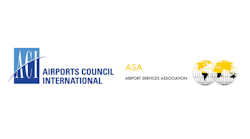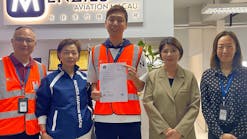Strengthening the Link Between Aviation Stakeholders
Earlier in this year, Airports Council International (ACI) and the Airport Services Association (ASA) released a new Ground Handling Service Provider (GHSP) and Airport Operator Agreement Template to facilitate and promote a safe and efficient aviation ecosystem.
The GHSP and Airport Operator Agreement Template is a free template produced by the two industry associations to facilitate the establishment of agreements between GHSPs and airport operators. A similar template agreement exists between GHSPs and air operators, produced by the International Air Transport Association (IATA), explains Thomas Romig, ACI World’s vice president of safety, security and operations.
The template is available for free on the ACI World store. The formats in which the agreement template is available are in word and pdf and should serve as a guide for organizations that decide to use it, according to Romig.
“It can be edited and adapted to suit the specific requirements being established between two organizations,” he says.
Where the Need Comes From
Some years ago, the ACI Safety Technical Standing Committee identified ground handling as a domain having a significant operational safety and performance impact on airport operations, observes Romig.
“The topic was discussed and reviewed from multiple angles with multitude stakeholders. It was agreed that actions were needed both through ACI and at the global level,” he says.
In 2016, a policy paper on ground handling, which called for the establishment of agreements between airport operators and GHSPs operating at airports, was published by ACI.
“This template was one of the next logical steps in achieving this strategic objective. It is purely guidance material based on best practices that airports and GHSPs are free to use,” says Romig. “Many airports already have some form of agreement in place – this document was originally built on best practices from multitude airports. In its second version – produced in February 2022 – a collaborative effort between ACI and ASA was set up to create a balanced document that reflects the needs and requirements of both parties.”
According to Fabio Gamba, director general of ASA, there was a need for a stronger link between the different stakeholders.
“It is a triangular situation with the airlines on one side, the airport itself on another side and then there are the ground handlers, which are the third leg of the tripod,” he says.
Traditionally there has been a link between airports and airlines, observes Gamba.
“There have been of course links between the ground handlers and the airlines and the ground handlers and the airports,” he says.
But together, Gamba points out, there had not been a link to allow harmonization between all three parties.
“An image that I like to use is that, as ground handlers, we are a bit sandwiched between the airlines and the airports,” he continues. “In the contract we have with airlines and the licenses with the airports there can be slightly different requests, sometimes even contradictory.”
For ASA, it was necessary to address this issue.
“It obviously differs from station to station, from country to country and from region to region up to a point where sometimes there is not even a license,” says Gamba. “Together with ACI, we thought that this should not be the case. We need to provide a concrete template to the world. The template provides for what we believe is the minimum set of requirements between an airport and a ground handler, irrespective of the contracts that this ground handler has with a specific airline.”
By addressing this, the relationship is getting clearer, according to Gamba.
“We are offering to the community a set of clauses that we believe should be adopted. We believe that any relationship needs to be framed somehow, and in the template there are useful elements that anyone can use,” he says.
The template has the aim to provide a useful tool to ACI and ASA members that are seeking to establish an agreement between them, affirms Romig.
“This can be used for new agreements or when renewing existing agreements. It also aims to facilitate the dialogue between airport operators and GHSPs when building up and formalizing their relationship,” he says.
Scope of the Template
The template has the aim to formalize the relationships between airport operators and GHSPs, highlights Romig.
“It covers all key aspects related to both parties’ responsibilities, such as the application of local airport rules and regulations, coordination mechanisms established between the parties, liability and responsibilities, the exchange of information and data, cooperation in case of emergency or abnormal operations, insurance requirements, etc.,” he says. “Best practices are at the base of the document. They are consolidated by both ACI and ASA – with the aim of finding a common and balanced approach to the agreements that are put in place.”
According to Romig, an annex on a draft service level agreement has been added to the template agreement.
“It has been left blank – i.e., without targets – as these need to be identified and discussed at a local level,” says Romig. “There are also provisions related to airport system performance that have been added – as the performance of a GHSPs can have a significant impact on the overall operation at an airport.”
In addition, the agreement template contains provisions related to ground damage of aerodrome infrastructure and property, adds Romig.
“The ground damage of aircraft is not covered in this document as it is already covered by the agreements with air operators,” he says.
The template has the aim to maintain a safe and sustainable practice of ground handling, observes Gamba.
“The airports need to bring this to the attention of the ground handlers and the ground handlers need to do it,” he says. “The template is a companion of best practice that in the experience of the ground handlers and the airports are the minimum to have a sustainable and safe relationship between the airports and the ground handlers and for the ground handlers to ensure a good, safe and reliable practice of their job.”
The template does not aim to become a standard but rather to provide a method of comparison, according to Gamba.
“The template provides for logical steps for the ground handlers to undertake. Most probably they are already undertaking them in some form. If that is the case, they do not have to do anything,” he says. “If they are undertaking the steps differently, they may want to ask themselves why they are doing things differently and perhaps get closer to what is proposed in the template. If the ground handlers do not undertake certain steps, then we highly suggest that they take the example of the wording that we are using in the template and try to implement accordingly.”







